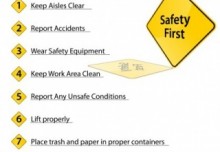
 Internal Management Safety Audits
Internal Management Safety Audits
Your safety program appears to be going well, no recordables for the past several months. The last Lost Time Accident (LTA) was back in 2012. Supervisors are conducting toolbox meetings every day, near misses area being reported and corrected. The new initiatives that were implemented after the last LTA seem to be working. But how do you really know how strong our safety program is? What can we, as safety leaders, do to ensure continued success?
Conduct an internal safety audit or “Internal Management Audit”
Take example company ABC Manufacturing, a small company with 100 employees. All of the OSHA required programs are in place. Employees are trained on the required OSHA standards and programs. Hearing tests are conducted annually. Respiratory fit testing is conducted annually. Employees attend monthly safety meetings. Every day, forms are filled out by line supervision that capture the toolbox topics and concerns for their daily toolbox meetings. Every day, there is at least one near miss report submitted by employees on the production floor. Everything seems in order.
However, it is probable that not all leading indicators are being discovered. Successful safety management programs contain a feedback loop. This feedback loop provides middle and upper management with a view to how the safety system is functioning. Things may seem like all is well, full steam ahead, but without the feedback loop, there is not a clear picture.
Most programs call this feedback loop auditing. The general definition of an audit, as shown in Wikipedia, is a planned and documented activity performed by qualified personnel to determine by investigation, examination, or evaluation of objective evidence, the adequacy and compliance with established procedures, or applicable documents, and the effectiveness of implementation. A simplified audit definition is a process to find out if you are doing what you say you are doing.
There are simple audits and complex audits. When assessing your safety program, have the management team conduct a couple of simple audits each month, this being your “Internal Management Audit”.
Setup a simple audit procedure where you would have a specific time twice a month to walk the floor and talk to a couple of employees. Set the timing so that you include different employees and as many employees over time as possible. Ask the employees some basic, yet specific questions during your audit. Talking with employees and asking a couple of questions can be very effective.
Questions like:
• What are you doing today to keep yourself safe?
• When is the last time you reviewed the procedure of the task you are performing?
• What was your toolbox topic today?
• Did you complete any pre-start inspections, written or unwritten?
• Where do you go to shelter for severe weather?
These are a few open ended questions that can be asked in an audit that takes less than five minutes. You can use these examples and make them specific to your company or situation.
Document each audits questions and answers. A simple form will be helpful for this. Once you have the answers to the audit questions, compile the answers for all the manager audits each month and present the findings. The management steering committee can use the findings to determine the effectiveness of the toolbox meetings, safety training, policy reviews or other questions that were asked. After a couple of months, more trends will appear, revealing leading indicators that will help shape and determine your program effectiveness. Based on the findings, if needed, you can modify the current direction of your safety program.
After sanitizing the findings so that no individual employees are pointed out, share the findings and any changes in the employee safety meetings. Graphs and charts are sometimes useful to convey this information. Employees know that if management deems safety important, then it is important. Routine management audits are a useful tool for employee engagement and determining program effectiveness.













